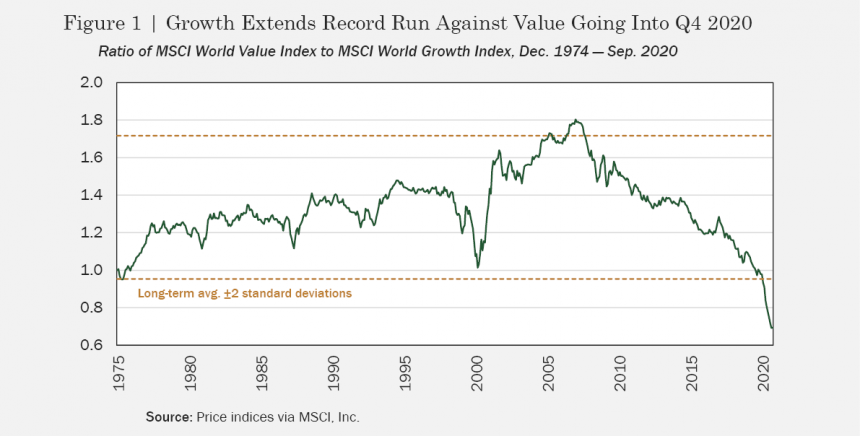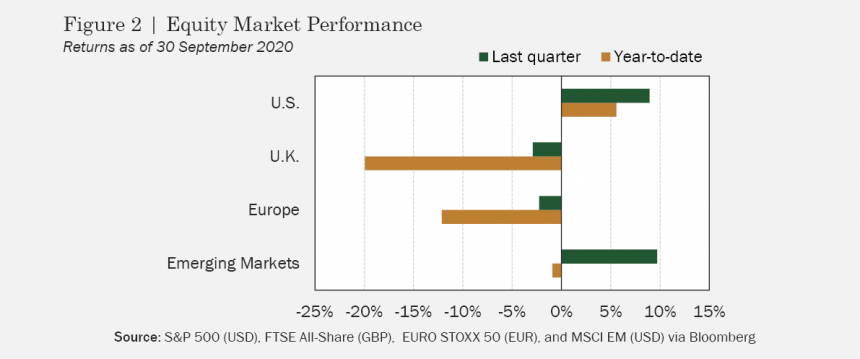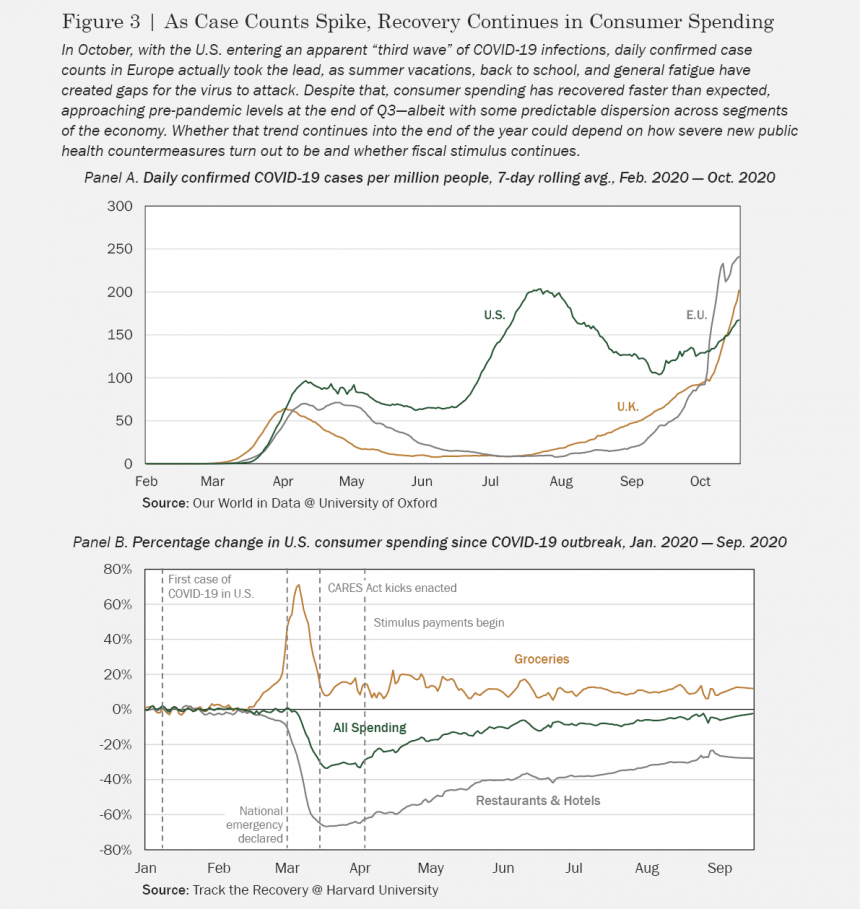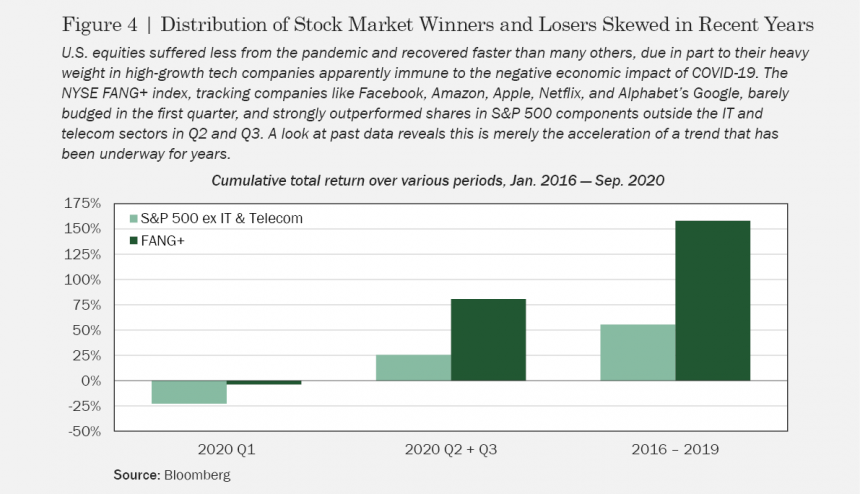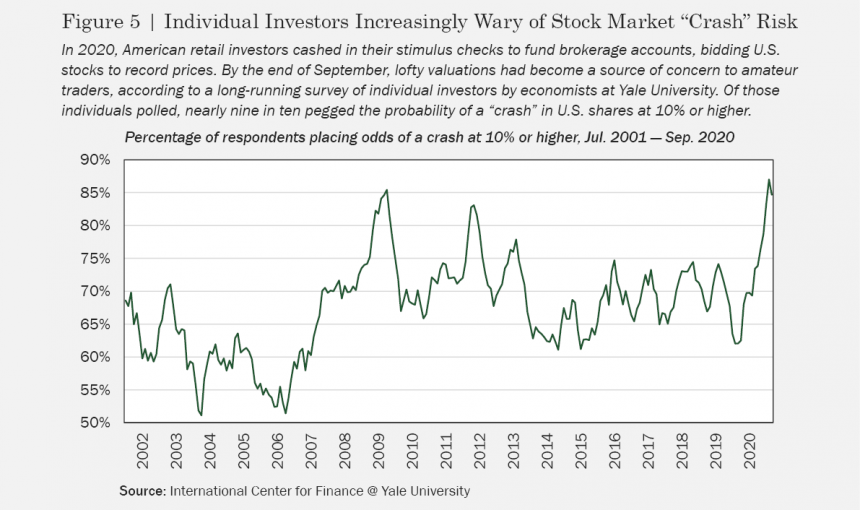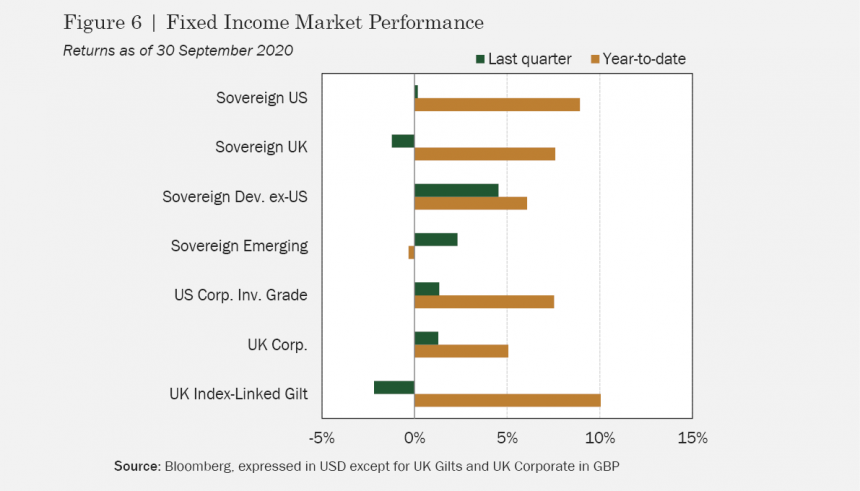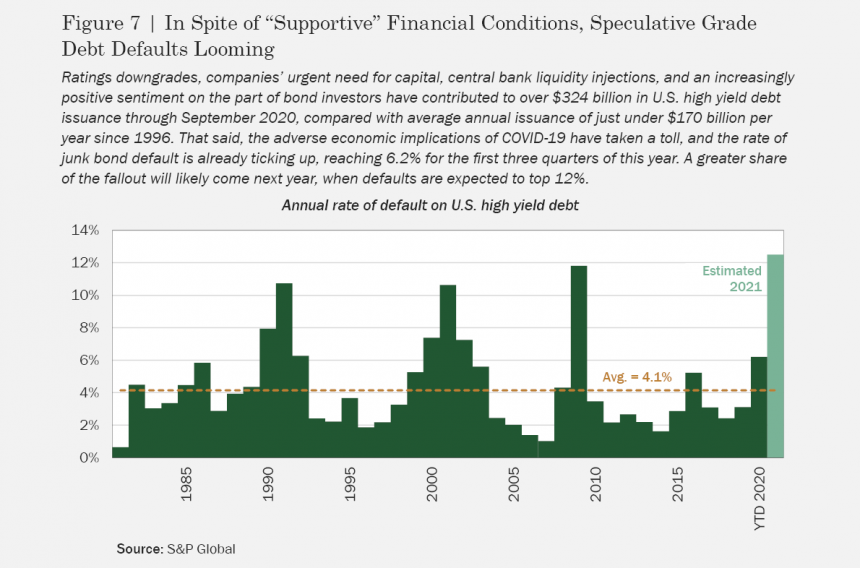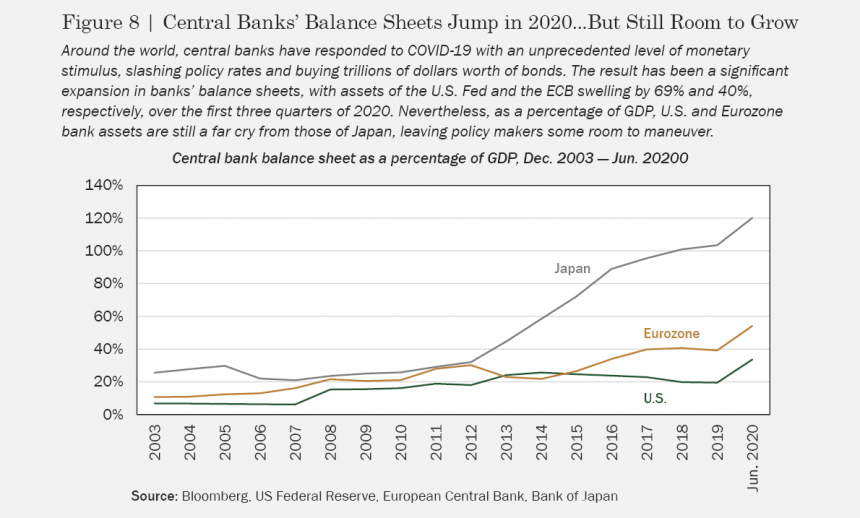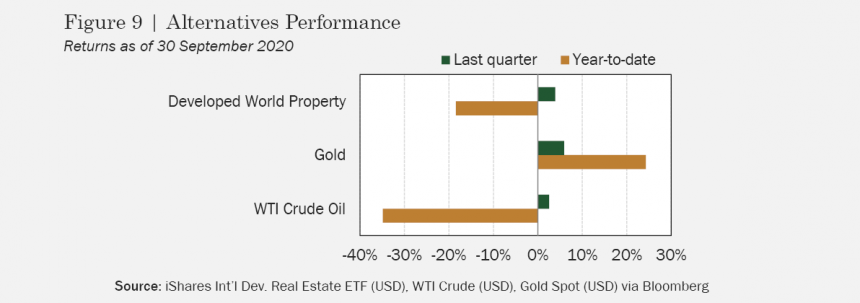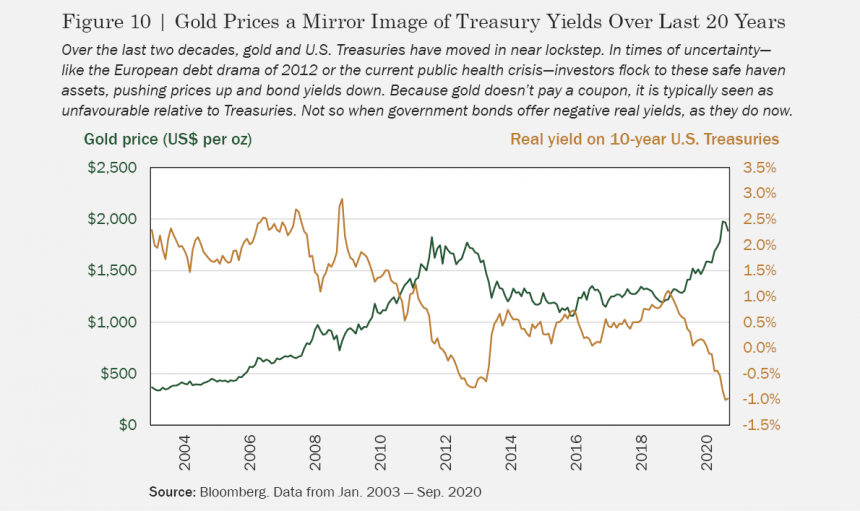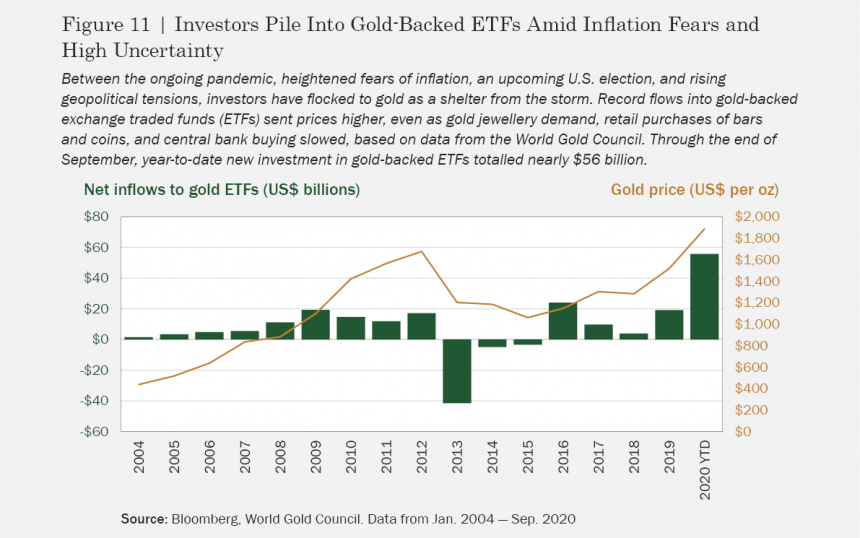Market Overview
As the not-so-United States of America headed into the most venomous Presidential election in living memory, the hatred between the two sides was exceeded by only one thing—the revulsion of investors for Value stocks. ‘Revulsion’ is not a particularly technical term, but it is the most fitting. The divergence between Value and Growth stocks is at record levels (see Figure 1), increasing almost daily as the US markets in equities and global markets in zero-yield government bonds hit nosebleed highs or hover round them. Why does nobody love the boring stocks priced near book value with decent, well covered, dividends? The answer is simple. Despite being cheap as chips they are not chasing the FAANGs to new highs and have languished in the doldrums for years. Low discount rates have a way of focusing the market on the attractions of heady but distant future profits, not the dull glint of money today.
But these conditions might soon change. The well-known deflationist Russell Napier has changed sides and now argues that we are entering an age of inflation. Deflation has been driven by technology and by globalisation, the latter in effect largely the impact of Chinese manufacturing on Western wages and consumer prices. But now, while governments have delivered the ultimate deflationary blow to their own economies by closing them down, they have simultaneously flipped the switch from QE to a very different regime. The State is suddenly guaranteeing enormous bank lending programmes, so it is no longer central banks in charge, but the governments themselves. This is an enormous change.
And not only have governments seized control of the banking system but they are financing small companies and furloughed workers, thereby directly injecting money into the real economy rather than financial markets. In the UK for instance, of one £55 billion loan programme, £35 billion has been lent to companies taking less than £50,000 apiece! The huge money pulse and the novel delivery mechanism risk impacting the real economy rather than financial asset prices. But surely spikes in unemployment are always followed by deflation? This may be true historically, but in the clash of forces today, government has just given itself the perfect tools to err on the side of growth, and we have just heard Fed Chair Jerome Powell say the 2% inflation target is now only a long-term measure. With the vast scale of lockdown capacity damage and its monetary remedy, we do not need to fine tune the calculation, as we know what Powell is planning.
The QE era has been marked by an artificial downward force on interest rates known as financial suppression, distortion of an essential market pricing mechanism. At its heart has been the attempt to avoid the creative destruction normally wreaked by recession, which subsequently allows systems to regrow stronger than before. It could be argued by the more heartless economists that we have missed the full opportunity offered by COVID-19 for creatively destroying whole industries, painfully sowing the seeds for the lucrative kind of growth seen after the 1990s Asian crisis. If governments now continue determining the amount and direction of bank lending—a convenient habit they may find hard to break—we could see even more massive levels of capital misallocation as we struggle on into the future. Over time this degrades and ultimately destroys investment returns, not to mention jobs.
Where does this leave us? First, take bonds, which tend not to do well in inflation. Today, there is the added problem that even though interest rates are officially capped by (heavily indebted) state intervention, the market is likely to demand higher yields on government bonds in regimes managed not by disinterested central bankers but by self-interested governments. Equities, on the other hand, tend to do well in the early stages of inflation. High fixed cost, asset heavy stocks—those much-derided Value plays—could at last come into their own in these conditions. Buffet’s recent $8 billion investment in Japan is a case in point here, as Japan is full of asset heavy candidates for the committed value investor. Perhaps now is the time to hold our noses and buy some of these revolting stocks. It is certainly a good time to be taking financial advice.
Asset Classes
Equities
The COVID-19 pandemic remained the biggest driver of stock market performance in the third quarter, although anxiety over the impending US Presidential Election and ongoing Brexit talks began to weigh on equities as the quarter came to a close. US stocks hit record highs in August on further signs of an economic recovery, then retreated in September amid doubts about further stimulus with the election approaching and concern over a second wave of infections exploding in Europe. US shares ended Q3 ahead by 8.9%, with consumer discretionary stocks leading the way (see Figure 2). Emerging markets also rallied in the third quarter, with strong economic data and dollar weakness pushing EM shares up 9.7% through the end of September. European equities finished Q3 down –2.3%, despite EU approval in July of a €750 billion fund for economic assistance to member states. UK stocks sold off by a modest –2.9% in Q3 on fears of chaos in the final stretch toward Brexit and the effects of a second lockdown.
Indeed, after months of warnings by health experts worldwide against the public succumbing to “COVID fatigue” and about the dangers of a new spike in cases as colder temperatures and holiday festivities bring people together indoors, confirmed case counts began predictably surging in Europe and the UK at the end of Q3 (see Figure 3, Panel A), quickly surpassing those in the US—which was just entering what looked like a third wave of infections—although Americans were not to be outdone, retaking the lead on all the wrong statistics shortly into the fourth quarter.
Of course, the ramifications for global equities would likely have been much worse, if not for better-than-expected news on the vaccine front, and the seemingly unstoppable force of consumer spending which, by the end of September, was nearing pre-pandemic levels (see Figure 3, Panel B). The obvious connection between fiscal stimulus and the ongoing business recovery has raised concerns among US investors that escalating political division during an election year might place future stimulus at risk. Perhaps unsurprisingly, the data also reveal winners and losers across segments corresponding to 2020’s familiar pattern of stay-at-home consumption, with shares in grocers outperforming hospitality, year to date, to take but one example.
This skewed distribution of spending hints at another major theme in global stocks and client portfolios through the first three quarters of 2020: the lopsided nature of economic and market success during a pandemic that has accelerated several disruptive trends, including a shift from old- to new-economy models for delivering goods and services to consumers and businesses. Leaders in this transition—firms like Facebook, Amazon, Apple, Netflix, and Alphabet’s Google—have been tracked separately by the NYSE’s FANG+ Index for years, strongly outpacing shares in those S&P 500 stocks outside the IT and telecom sectors from 2016 through 2019 (see Figure 4). This dominance only picked up pace in the face of COVID-19, with lockdown-resistant FANG+ shares losing just –4% in Q1, versus a –23% decline in the broader market. New-economy juggernauts rapidly extended those gains in the second and third quarters as the commercial landscape adapted to severe public health constraints, with FANG+ stocks rallying by 81%, versus a less impressive 26% rebound in the S&P ex IT and Telecom.
The imbalanced rally in stocks since early 2020 has been fueled, at least in part, by a surge in retail enthusiasm that saw individual investors stuck at home put their stimulus money to work punting on equities in a manner reminiscent of the late-1990s tech bubble. Illustrating that trend, market makers report that US retail orders, which typically account for less than 5% of overall trading in recent years, have climbed to 20% or more of total volume since the pandemic began. Nevertheless, by the end of the third quarter, data suggest that even these amateur traders were questioning lofty valuations in US stocks. One indication comes from Yale University’s Professor Robert Shiller—a leader in the study of investor behavior and stock market bubbles, and recipient of 2013’s Nobel Prize in Economic Sciences—who has been surveying individual traders on their views about US markets since 1989. Based on his data, as of the end of Q3, nearly nine in ten individual investors assigned at least a 10% probability to a “crash” in US shares in the next six months (see Figure 5). What could precipitate such a fall? Negative surprises in macro data tracking the economic recovery or, conversely, a vaccine-induced reversal of the aforementioned tech tailwinds, not to mention destructive escalation in trade tensions, are among the key risks facing stocks as 2020 draws to an end.
Fixed Income
Bond markets were relatively quiet in the third quarter, characterised by investors’ move to a “risk on” attitude, which saw weaker returns for safe-haven US government debt, up just 0.18% for the quarter, but better performance among riskier US and UK corporate bonds, each adding 1.3% through the end of September, and EM sovereign debt, which gained 2.3% in Q3 (see Figure 6). Naturally, the strongest returns within corporate bonds were in the high yield space, which tends to rally when buyers’ appetite for risk grows. Eurozone debt gave developed ex-US sovereign bonds something of a boost in Q3, with the announcement of a €750 billion recovery fund, leading to investor optimism and generally falling yields. Meanwhile, UK sovereign bonds and index-linked gilts lost –1.2% and –2.2%, respectively, in Q3, after posting strong performance in the previous quarter.
Notwithstanding a positive trend in sentiment among bond investors, a number of the credit market risks we flagged last quarter began to materialise in the second half of 2020. A rash of downgrades made for a larger pool of speculative-grade issuers in Q3, while continued economic restrictions placed more pressure on companies to raise capital. At the same time, increased investor demand for risk assets, along with accommodative policy on the part of central banks, made it easier for lower-quality borrowers to tap credit markets. These factors combined to produce $324 billion in US high yield debt issuance through September 2020, versus just under $170 billion per year in average issuance since 1996. Of course, they call high yield “junk” for a reason, and defaults on speculative-grade debt have quietly advanced to 6.2% through the first three quarters of the year (see Figure 7). S&P Global expects the situation to get worse next year, when they project defaults on high yield credit could exceed 12%.
In light of such risks to bond investors, there has been some question as to the amount of “dry powder” central banks have at their disposal to address future financial calamities. To be sure, banks’ balance sheets have ballooned this year, with the US Fed and ECB expanding their assets by 69% and 40%, respectively, over the first three quarters of 2020. According to analysis by Nordea Markets, the Fed has created over $3 trillion in new money so far this year, implying nearly 20% of all US dollars in circulation were “printed” in 2020. While such statistics are no doubt startling, policymakers are likely not as limited as many investors think. As a percentage of GDP, US and Eurozone bank assets are still a far cry from those of Japan (see Figure 8), providing plenty of room for bankers to continue operating to stabilise markets—and support asset prices—for the foreseeable future. The willingness seems to be there, as well, with the Fed’s Q3 announcement of an “inflation averaging” approach, allowing its target inflation to occasionally drift above 2%, further stoking hopes for more monetary stimulus.
Alternatives
Compared to the first half of 2020, alternatives saw much less action in Q3. In the commodity space, oil prices recovered modestly, up by 2.6% in the last three months (see Figure 9), as generally upbeat economic figures were tempered by continued weak demand for jet fuel on the part of struggling airlines, risk of a devastating second wave in the pandemic, uncertainty about further OPEC supply cuts, and concerns over a warm winter. REITS, which have been hit hard by COVID-19, posted positive returns of 3.9% in Q3, solidly underperforming broader equities over the last three months. According to Nareit, office and retail properties fared worst in Q3, returning –7.5% and –4.1%, respectively, while timberland and self-storage were the top property sectors, adding 22.1% and 16.9%, respectively. The lodging/resort segment lost little ground in Q3, down just –1.4%, but remains the most badly beaten sector of the property market in 2020, shedding just over half its value so far this year.
Gold extended its gains in the third quarter, advancing by 5.9% over the last three months, bringing its year-to-date return to 23.4%, making it one of the best performers among alternative assets in 2020. Gold’s record run, bringing it above $2,000/oz. for the first time ever in August, has come at a time of profound uncertainty. This is not surprising, as periods of market stress—like 2012’s European Debt Crisis or this year’s pandemic—often prompt investors to bid up the prices of gold and US Treasuries in a flight to safety. That dynamic has resulted in gold prices and T-bill yields, which have an inverse relationship with prices, moving in near lockstep over the last two decades (see Figure 10). Investors seeking safety no doubt accounts for gold’s gains in 2020, with flows into gold-backed ETFs totalling almost $56 billion over the nine months ending in September, according to the World Gold Council (see Figure 11), as investors braced against a once-in-a-century public health crisis, inflation fears, a divisive US election, and escalating geopolitical tensions.
Looking Ahead
At times when things feel even more precarious than usual it is only natural to look for answers in the deep past. It is there, as Joseph Tainter explains in his 1988 monograph, The Collapse of Complex Societies, that we discover a duo of systemwide negative-NPV decisions on the one hand, and currency debasement on the other, explain most historic cases of large-scale social collapse. Even investors of a less apocalyptic bent can be forgiven for seeing strained global debt service levels and impressive fiscal deficits as a scary backdrop for such potentially incendiary events as a US election and Brexit negotiations, let alone continuing COVID-19 lockdown measures, and the emergence of a new cold war between the US and China. On the bright side such worries tend to characterise bull markets.
Efforts to deal with the pandemic and even kickstart growth are intensifying as central banks jettison inflation ceilings and governments seize control of banks to pump money into their economies at any cost. The only certainty for investors is that the landscape has irrevocably changed, and monetary stability is likely a thing of the past. The coming expansion may have to fight to match inflation, such periods of growth being bad news for bonds and not necessarily good for equities. In any case, bond values are so high their medium-term returns can only be poor.
Meanwhile, there is a huge valuation disparity between US equities and the rest. US performance has been driven by the ‘FAANG’ stocks plus Microsoft—together effectively a new asset class at 24% of the S&P 500. The rest of the US market looks more like other developed indices. Those other indices have de-rated, becoming less valuable, as yields have fallen, while the US remains stubbornly high. Gerard Minack of Minack Advisors has found an inverse relationship between the Cyclically Adjusted P/E (CAPE) ratio and subsequent growth, but reckons we are about to enter a period similar to the inflationary decade from 1974 to 1984, in which returns for any given valuation were consistently lower than in the heady years from 1997 to 2008. Of course, stark valuation differences present investors with opportunities. The UK is among those markets which are particularly beaten down, while inflation favours high fixed cost utilities and manufacturers, as would a flood of CapEx into onshoring away from emerging markets like China, to pump-prime growth in developed economies. And coming up fast is what we see powering the FAANGS, a bunch of entirely new technology ecosystems.
Key Economic Releases & Events for Q4 2020
UNITED KINGDOM
Bank of England Official Bank Rate: 5th November, 17th December, 4th February
PMI Figures: 23rd November, 1st December
EUROZONE
YoY GDP: 30th October, 13th November, 8th December
PMI Eurozone: 23rd October, 23rd November, 3rd December
Unemployment Report: 30th October, 13th November, 8th December
ECB Monetary Policy Meeting: 29th October, 12th December, 21st December
UNITED STATES
FOMC Rate Decision: 5th November, 16th December, 27th January
GDP Figures: 29th October, 25th November, 22nd December
PMI Figures: 23rd October, 23rd November, 30th December
Closing Comments
To understand the market, it’s important to keep an eye on the bigger picture. Unfortunately, we often find that macroeconomic projections rely on precious few data points relative to those available for the mass of equity market signals we use to score thousands of global stocks. As for headlines, events of the last two years have demonstrated that these are almost entirely unpredictable, poor bases on which to make investment decisions. The signals we use, by contrast, have demonstrable impact on performance across a wide range of markets and over a long period of time. Some are common sense: the most highly geared stocks tend to have a tougher time when they hit a bump. Others are less intuitive: Companies that issue large amounts of paper on the back of exciting stories tend to underperform those that focus on paying a boring dividend; alternatively, if there is a big earnings surprise, good or bad, it tends to affect price not just on the day of the announcement but in the share direction for months after. Combining a wide range of such signals to shape a portfolio is Rayliant’s bread and butter, and these are essential tools in our stock picking process. At the same time, those tools aren’t static and our study of market history and emerging macroeconomic trends—including the way businesses and markets have changed in the face of COVID-19—critically informs the way we research and implement our strategies, ensuring our approach adapts as the bigger picture unfolds.
IMPORTANT INFORMATION
This publication does not constitute a financial promotion as defined by Section 21 of the Financial Services and Markets Act 2000 (FSMA).
This document is intended for the use and distribution to all client types. It is not intended for distribution to, or use by, any person or entity in any jurisdiction where such distribution would be unlawful and participation in the portfolio referred to herein shall not be offered or sold to any person where such sale would be unlawful. Any onward distribution of this factsheet is strictly prohibited. The value of investments and the income from them can go up as well as down and you may realise less than the sum invested. Some investments may be subject to sudden and large falls in value and you may realise a large loss equal to the amount invested. Past performance is not an indicator of future performance. If you invest in currencies other than Sterling, the exchange rates may also have an adverse effect on the value of your investment independent of the performance of the company. International businesses can have complex currency exposure. Nothing in this document constitutes investment, tax, legal or other advice by Henderson Rowe Limited. You should understand the risks associated with the investment strategy before making an investment decision to invest.
Investors should be aware of the risks associated with data sources and quantitative processes used in our investment management process. Errors may exist in data acquired from third-party vendors, the construction of model portfolios, and in coding related to the index and portfolio construction process. Information contained in this fact sheet is based on analysis of data and information obtained from third parties. Henderson Rowe Limited has not independently verified the third-party information. The firm, its directors, employees, or any of its associates, may either have, or have had, a position, holding or material interest in the investments concerned or a related investment.
